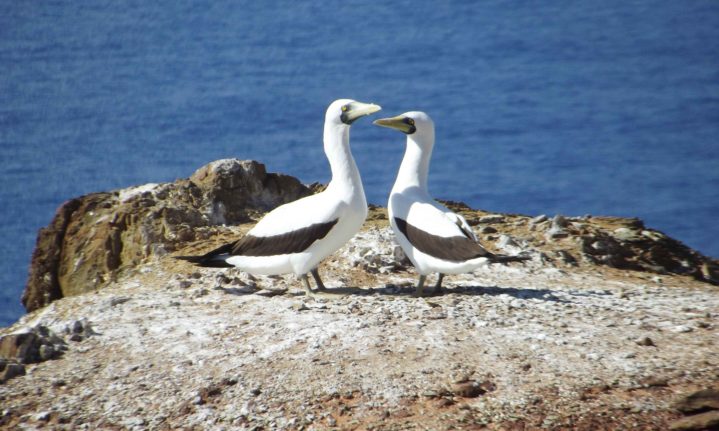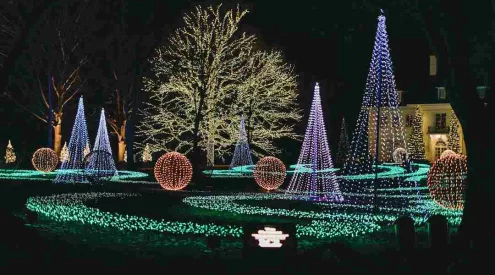This remote island is a great place to swim with whale sharks – and see other curious creatures, says Sarah Kingdom.
Out of the planktonic gloom, an alarmingly large, wide-mouthed creature appeared. Whale sharks are the largest fish in the world and there are few things that will take your breath away quite like your first encounter with one. They may have teeth like sandpaper and a gullet the size of a cricket ball, but your adrenaline kicks in regardless when you see one of these ‘sea-monsters’ heading your way.

The pattern of spots and stripes on the skin of whale sharks is unique to each individual
I spent a lot of time ‘back peddling’, as the shark’s curiosity got the better of her. She seemed to be following me in a slow-motion game of tag. Remora sucker fish clung to her sides and pilot fish led her through the ocean like a tug boat towing a cruise liner.
While whale sharks can often be found around St Helena in groups of up to 30, we were content with our lone female … at 18 metres long and weighing around 20 tons, one is quite enough to keep your eye on!

Whale sharks will often approach swimmers for a closer look
Whale-shark encounters are strictly snorkelling-only, but there’s much more to see in this ocean. Having not scuba dived for over a year, I felt more than a little like a ‘fish out of water’. Balancing on the edge of the boat, I fidgeted with my gear, but the moment I entered the water and saw the wonderland around me, I knew I’d be fine.
Clouds of endemic St Helena butterfly fish surrounded me, a mesmerising swirl of confetti in the gin-clear water. Everywhere I looked there were sh of every shape, colour and size, from parrot fish, cow fish and soldier fish to beautiful turquoise-green St Helena wrasse.
It’s easy to love diving in St Helena – visibility is up to 30 metres and water temperatures range from 19 to 26 ̊C. Numerous wrecks, reefs, islands and caves are all within a short boat ride of Jamestown.

The view from Diana’s Peak, the highest point on the island
The island is part of a small chain of submarine volcanoes in the mid-Atlantic, though it’s the only one that breaks the surface. Its remoteness has given rise to a rich ecosystem of unique flora and fauna.
Taking a break from the water, we went in search of the national (and only surviving endemic) bird, the small St Helena plover or ‘wirebird’. We found a nest – really just a shallow scrape in the soil with a few dried-up grass stems for lining, and arrived just in time for ‘changing of the guard’ on the eggs. The female returned to take over nest-sitting duty from her partner, and as we watched they performed a little shuffle and dance. The male then scurried off, with barely a backward glance, like it was opening time at the pub.
We finished off our afternoon at South West Point, watching the sun go down on an endless silvery ocean. Driving back to town, mist came sliding in over peaks and buttresses, shrouding the island in secrecy.
Morning dawned bright and sunny, perfect for hiking to Lot’s Wife’s Ponds. We trekked through a surreal, barren landscape – a vast sun-baked amphitheatre of ridges, striped purple and brown, with outcrops of lava. We passed breeding colonies of masked boobies before reaching a rope, strung casually down the side of a cliff … our way down to the enticing rock pools below. Reaching the bottom, we flopped into the water, instantly surrounded by curious fish. Greenfish, parrotfish and endemic ‘five fingers’ circled our bodies; octopus, sea urchins and starfish hid among the rocks below.
Inland, the severe coastal cliffs give way to gentle rolling hills ringed with dramatic ridges and valleys. The centre of the island rises to a crescent-shaped ridge, where you’ll find Diana’s Peak, the highest point at 820 metres. We climbed through tree-fern thickets, saw endangered whitewoods, dogwoods and black cabbage trees, as well as rare golden sail spiders and blushing snails. This cloud forest is the only remaining densely vegetated area of St Helena, and we had stunning views.

Masked boobies are spectacular divers, plunging near vertically from heights of up to 100 metres
Our final morning dawned and we decided on a quick snorkel in Jamestown harbour before our flight. I swam through clouds of butterfly fish and found, just metres from the harbour wall, a shipwreck. The SS Papanui exploded and sank in 1911; rudder, boilers, bits of engine lay below me, while a green turtle glided past. Why had I left it to the last morning to discover what had been waiting just a few metres from my hotel?
Getting there
Airlink flies to St Helena from Joburg on Saturdays, from R14,000 return (flyairlink.com). There will also be a Tuesday flight from Cape Town during December 2019 to February 2020, then from Joburg until end of March, which is whale-shark season. For more info, see sthelenatourism.com.
Stay here
The Mantis St Helena hotel is offering Getaway readers a 10% discount on bookings until
30 April 2020. Email st.helena@ mantiscollection.com, quoting ‘Getaway’. Usual rates are from R3,160 per person sharing B&B. mantissthelena.com
Do this
Aaron’s Adventure Tours and MY St Helena Tours offer guided hikes and walks, including searching for the wirebird. Mail [email protected] or [email protected] and find them on Facebook. Dive Saint Helena and Sub-Tropic Adventures offer whale-shark snorkelling trips and general scuba diving. divesthelena.com and stadventures.com
Words and images: Sarah Kingdom




















